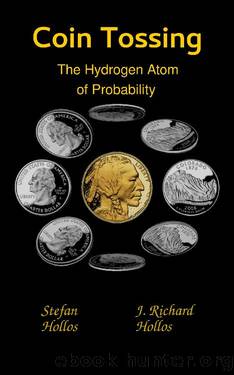Coin Tossing by Stefan Hollos & J. Richard Hollos

Author:Stefan Hollos & J. Richard Hollos [Hollos, Stefan & Hollos, J. Richard]
Language: eng
Format: epub
Tags: generating functions, probability theory, distributions, stochastic processes, tutorial, mathematics, markov chains
ISBN: 9781887187398
Publisher: Abrazol
Published: 2019-05-01T06:00:00+00:00
Run Occurrence Probability
What is the probability that a run occurs on toss n? The fn values that we have been looking at give the probability that a run occurs for the first time at toss n. Now we simply want the probability that it occurs at toss n, not necessarily for the first time. Let an be the probability that a run of length r appears on the nth toss then we can get a recursion equation for an by looking at all the ways you can have r heads in a row at toss n. If the run occurs at toss n then by definition there are r heads in a row and this has probability an. If the run occurs at toss nâ ââ 1 followed by a head then there will also be r heads in a row and this has probability panâ ââ 1. Continuing on like this you can go up to having the run occur at toss nâ ââ râ +â 1 followed by râ ââ 1 heads to have r heads in a row at toss n. Summing up all the possibilities gives the following equation
(164)
This equation is of course only valid for n greater than or equal to r with the initial conditions being anâ=â0 for nâ<âr. To find the generating function just multiply both sides of the equation by zn and sum from nâ=âr to â (note that a0 is defined as being equal to 1 here). The generating function is then
(165)
The an probabilities can be related to the fn probabilities by looking at all the ways a run can occur on the nth toss. It can occur for the first time on the nth toss with probability fn. It can occur at toss 1 and not reoccur until nâ ââ 1 tosses later with probability fnâ ââ 1a1 or it can occur at toss 2 and not reoccur until nâ ââ 2 tosses later with probability fnâ ââ 2a2 and so on. Summing up these probabilities gives
(166)
This equation is valid for nââ¥â1. Multiply both sides by zn and sum from nâ=â1 to â and you get
(167)
So the two generating functions are related to each other as follows
(168)
(169)
Equation (168) could have been anticipated since when a run occurs at toss n, it is either the first, second, third or higher occurrence, therefore an must be equal to
(170)
This means the generating function for an must be equal to
(171)
which is just the expansion of equation (168)
Download
This site does not store any files on its server. We only index and link to content provided by other sites. Please contact the content providers to delete copyright contents if any and email us, we'll remove relevant links or contents immediately.
| Biomathematics | Differential Equations |
| Game Theory | Graph Theory |
| Linear Programming | Probability & Statistics |
| Statistics | Stochastic Modeling |
| Vector Analysis |
Modelling of Convective Heat and Mass Transfer in Rotating Flows by Igor V. Shevchuk(6406)
Weapons of Math Destruction by Cathy O'Neil(6206)
Factfulness: Ten Reasons We're Wrong About the World – and Why Things Are Better Than You Think by Hans Rosling(4711)
A Mind For Numbers: How to Excel at Math and Science (Even If You Flunked Algebra) by Barbara Oakley(3251)
Descartes' Error by Antonio Damasio(3247)
Factfulness_Ten Reasons We're Wrong About the World_and Why Things Are Better Than You Think by Hans Rosling(3216)
TCP IP by Todd Lammle(3154)
Fooled by Randomness: The Hidden Role of Chance in Life and in the Markets by Nassim Nicholas Taleb(3079)
Applied Predictive Modeling by Max Kuhn & Kjell Johnson(3038)
The Tyranny of Metrics by Jerry Z. Muller(3025)
The Book of Numbers by Peter Bentley(2928)
The Great Unknown by Marcus du Sautoy(2661)
Once Upon an Algorithm by Martin Erwig(2620)
Easy Algebra Step-by-Step by Sandra Luna McCune(2603)
Lady Luck by Kristen Ashley(2552)
Police Exams Prep 2018-2019 by Kaplan Test Prep(2514)
Practical Guide To Principal Component Methods in R (Multivariate Analysis Book 2) by Alboukadel Kassambara(2512)
All Things Reconsidered by Bill Thompson III(2369)
Linear Time-Invariant Systems, Behaviors and Modules by Ulrich Oberst & Martin Scheicher & Ingrid Scheicher(2346)
